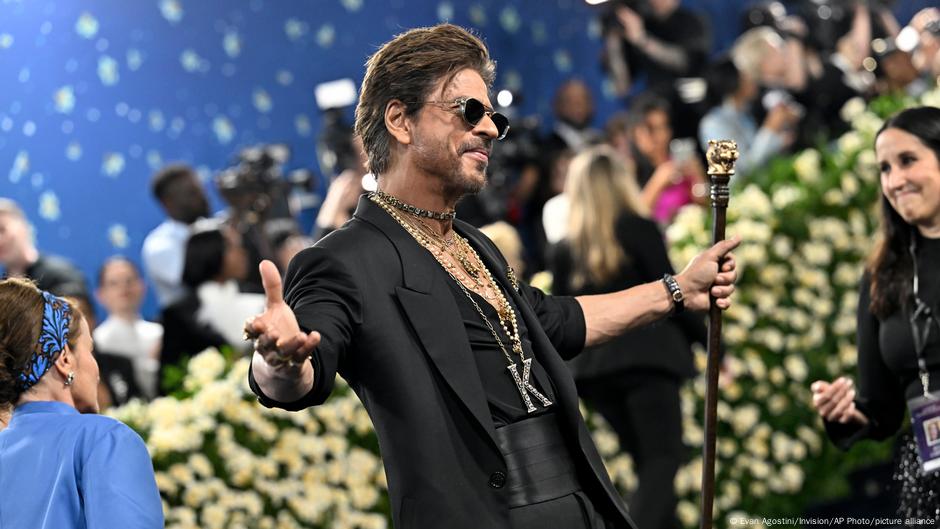Gen Z remixed it. Millennials grew up with them. The boomers saw him get up.
For millions of people within and outside India, Shah Rukh Khan (aka SRK) remains one of the most recognizable and resonant icons of the Hindi film industry.
This year alone, the actor, who turns 60 on November 2, has seen several viral moments: In May he became the first Indian male actor to walk the Met Gala red carpet, in June he made a cameo in Ed Sheeran’s “Sapphire” video, and in October he went viral for a selfie he took in Riyadh with South Korean “Squid Game” star Lee Jung-jae — an image that some fans called “the collab of the century.”
Searches about him were done in Google Trends from Mauritius to Myanmar. So what is there in his myth that transcends time, stage and countries?
the man behind the myth
Since its debut in 1992, Khan has played a variety of roles in over 80 films: the romantic ideal in “Dilwale Dulhania Le Jayenge” (1995), which still plays in a cinema in Mumbai; A disgraced hockey coach in search of redemption in “Chak De! India” (2007); and a vigilante fighting government incompetence and corruption in “Jawaan” (2023) – in which he plays six avatars, each mirroring earlier film personas. In September he received his first Indian National Film Award for Best Actor.
Vera Wessel, editor in chief of the German-language Bollywood-focused magazine Ishq, said that Shah Rukh can evoke emotions like no other actor – “Even his fans sometimes struggle to explain why he has this effect on them.”
Shahrukh once told American television host David Letterman: “I am an employee of the Shahrukh Khan myth.”
Through the lens of fans
The female gaze on his myth was deftly covered by economist (and SRK fan) Shrayana Bhattacharya in her 2021 book, “Desperately Seeking Shahrukh: India’s Lonely Young Women and the Search for Intimacy and Independence.” Using Khan as a “narrative device”, she asked Indian women of different ages and social strata to “talk about their frustrated attempts to claim economic and emotional independence in one of the world’s most insidious patriarchies.”
Bhattacharya believes that Khan’s image is refracted through the realities of those who watch him on screen. For a migrant tribal domestic worker, her onscreen gestures of care – helping domestic singers, living in feminized domains – provide rare validation in a country where men’s participation in care labor is among the lowest globally. For the elite, he embodied the myth of meritocracy during India’s neoliberal era. And for first-generation female professionals, her films provided emotional respite from their quiet rebellion of choosing career over marriage.
“After tracking the lives, livelihoods and love affairs of his female fans for 15 years, I know there is no linear thesis on Khan’s iconography,” Bhattacharya told DW. “He’s one person, but each fan has projected their own aspirations and fantasies onto him in their own unique and deeply diverse ways.”
Remixed by Gen Z
Unlike the loyal fan bases of 90s boy bands, many of Khan’s fans have traveled and matured with him, sometimes passing the “bug” on to their offspring. His films depicting the lives of Indians living abroad also influenced the vast Indian diaspora, estimated at 35 million, and introduced non-Indian fans to Hindi cinema in the process.
Wessel said, “With India being the most populous country in the world and a huge market, I don’t think Khan needs to make efforts to expand his stardom.”
Referring to Khan’s cameo in Sheeran’s “Sapphire” video, Wessel said: “I’m absolutely convinced that it makes sense for people like Ed Sheeran to know him and now to work with him, not just the other way around.”
Khan seems to be effortlessly inspiring mashups, memes and TikToks with Gen Z. These often include songs he performs in his films, to which he lip-syncs – as in many Indian films – while expressing emotions with his trademark outstretched arms movements and expressive eyes.
Canadian Indian rapper Teshar’s 2020 track “Young Shahrukh”, which samples a song from Khan’s 2001 hit film “Kabhi Khushi Kabhie Gham”, has received over 20 million views on YouTube. Khan himself has danced to this tune on several occasions.
Similarly, British singer Dua Lipa’s 2020 hit “Levitating” was crushed along with the hit “Woh Ladki Jo” from Khan’s 1999 film “Baadshah”. Lipa performed this version with dance steps from the film at an event in Mumbai last year, which thrilled fans. They included Khan’s daughter Suhana, who is also now an actress, who posted an Instagram story of the moment, complete with heart-touching emojis.
timeless icon
Wessel attributes Shah Rukh’s continued relevance to his business acumen, saying that he was among the first Indian stars to successfully connect with his fans online. His work promotes big brands, some of which he highlights on his 48.8. Million Instagram followers have given her a strong voice as well as continued commercial success.
“And, whenever he uses that voice, whether it’s in his films or in public appearances, he spreads a message of hope and understanding with simple words and cheeky humor,” Wessel said.
Weasel said Khan will likely be front and center in future films – “BBecause trends come and go, but their popularity remains eternal.”
Edited by: Christina Barak






Leave a Reply